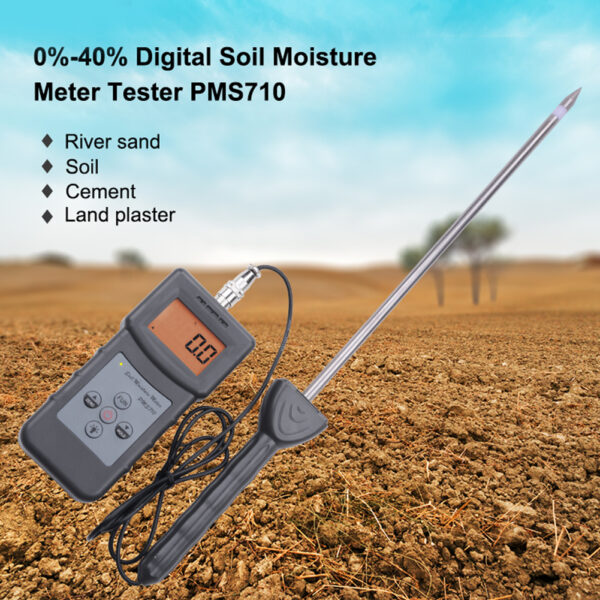Moisture Meter Buying Guide: What to Seek in High-Quality Instruments
Moisture Meter Buying Guide: What to Seek in High-Quality Instruments
Blog Article
Delve Into the World of Moisture Meters: Everything You Need to Know
In the world of moisture meters exists a globe of accuracy and usefulness that often goes undetected. These devices, while relatively straightforward, hold a wide range of information that can substantially impact numerous markets and applications. Comprehending just how moisture meters run, the different kinds available, and their diverse uses can clarify their relevance in making certain top quality and effectiveness. By checking out the complexities of moisture meters, one can uncover an important device that goes beyond mere dimension, offering insights that can make a considerable difference in many fields.
Just How Moisture Meters Work
Moisture meters operate by determining the electric conductivity or capacitance of products to identify the wetness web content present. These meters are important tools throughout different industries, consisting of agriculture, woodworking, and construction. By utilizing various techniques such as pin-type or pinless modern technology, dampness meters give exact analyses that assist professionals make informed choices.
Pin-type dampness meters work by inserting the sharp pins into the product being examined. On the various other hand, pinless wetness meters utilize electro-magnetic signals to check a larger area without creating any type of damages to the product's surface.
Regardless of the approach utilized, dampness meters play a critical duty in avoiding problems such as mold growth, architectural damages, or product flaws triggered by excess dampness. Comprehending just how these meters job is important for guaranteeing the quality and honesty of materials in various applications.
Kinds Of Moisture Meters
Offered the crucial function dampness meters play in various sectors, it is necessary to comprehend the various types readily available to specialists for accurately examining wetness levels - Moisture Meter. There are mostly 2 main kinds of dampness meters: pinless and pin-type moisture meters

On the various other hand, pinless wetness meters use electro-magnetic sensor plates to check a larger location of the product without causing any kind of damage. This type is ideal for rapidly scanning big areas and is generally utilized for floor covering, walls, and ceilings. Pinless meters are practical for taking analyses on completed surface areas without leaving any type of visible marks.
Both kinds of dampness meters have their benefits and are picked based upon the specific needs of the job handy. Comprehending the distinctions between these kinds is vital for specialists to make precise moisture analyses.
Applications Across Industries
Building and construction experts depend on dampness meters to assess the wetness degrees in building products like wood, concrete, and drywall, which is critical for preserving architectural integrity and protecting against problems like rot or mold and mildew. The floor covering sector makes use of dampness meters to gauge the wetness content in subfloors before mounting numerous flooring coverings, avoiding expensive problems due to excess wetness. In the food sector, wetness meters are made use of to keep track of and control moisture degrees in products such as grains, nuts, and dried out fruits to keep freshness and top quality.
Tips for Making Use Of Wetness Meters
Use the moisture meter's calibration setups to ensure exact analyses when determining the moisture content in numerous materials. Calibration is vital for the appropriate performance of a wetness meter. Before each check my source usage, it is advisable to inspect and readjust the calibration settings according to the certain product being examined. Additionally, make certain the meter is established to the right moisture array for the material you are determining to get one of the most specific results.
When utilizing a pin-type dampness meter, place the pins to the appropriate deepness recommended for the material being examined. This makes sure that the dampness analyses are taken Get the facts from the appropriate deepness within the product, providing a more exact representation of its dampness material. For pinless wetness meters, remember to preserve correct call with the product's surface area to get trusted readings.
On a regular basis inspect and change the batteries in your wetness meter to stop unreliable analyses as a result of reduced power. Shop the meter in a dry and secure place when not in usage to lengthen its lifespan and maintain its precision. By complying with these suggestions, you can take full advantage of the performance of your wetness meter and get specific moisture content dimensions throughout various materials.
Maintenance and Calibration
To make certain the precision of wetness web content dimensions, normal upkeep and calibration of the wetness meter are important steps in its appropriate performance. Calibration readjusts the moisture meter to make sure that it offers constant and reliable results.
Calibration ought to be carried out occasionally, especially if the wetness meter is made use of frequently or in important applications where accurate measurements are called for. Several moisture meters come with calibration devices or can be adjusted by professional services. Moisture Meter. It is recommended to maintain a log of calibration days and results to track the performance of the moisture meter gradually. By maintaining and adjusting the moisture meter regularly, customers can trust the accuracy of the dampness material dimensions obtained.
Conclusion

Finally, wetness meters play an essential function in various markets by properly determining the dampness content of materials. Recognizing just how these tools function, the different kinds available, and proper maintenance and calibration are crucial for getting trusted results. Whether in manufacturing, agriculture, or construction, making use of moisture meters assists guarantee quality assurance and performance in procedures.

In final thought, dampness meters play an important function in various sectors by precisely gauging the moisture web content of products.
Report this page